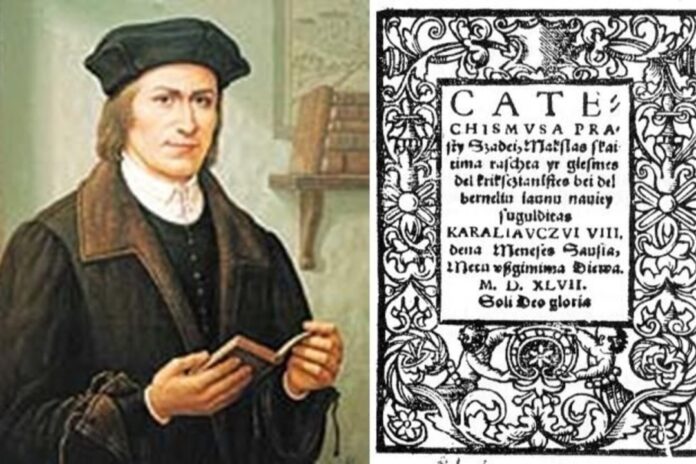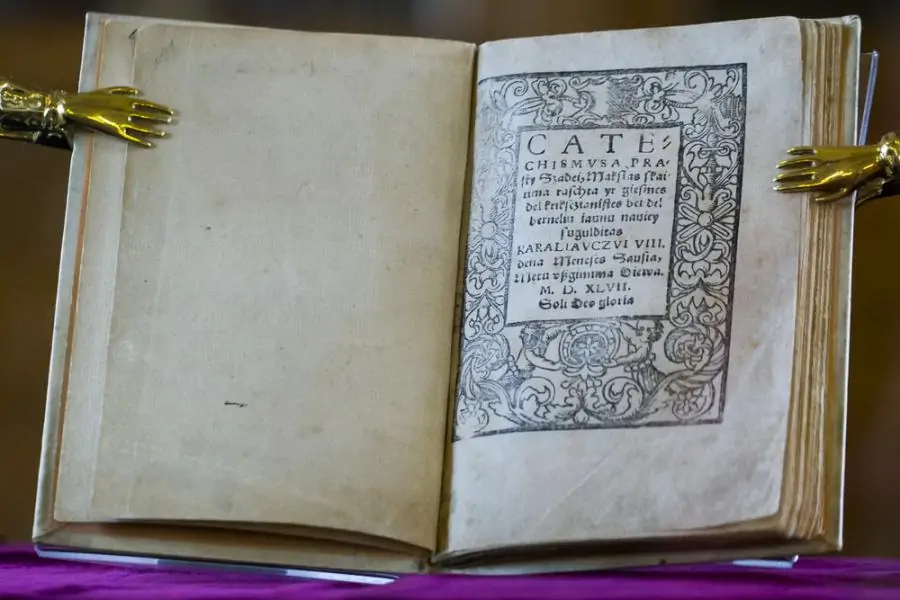
An event most special to the Lithuanian language is celebrated every year on January 8. This year it was the 475th anniversary of the very first book published in Lithuanian, the Catechism (Katekizmas) by Martynas Mažvydas. He was a Lithuanian writer, reformist and Lutheran minister who wrote and published the modest 79-page Catechism in 1547.
The language of the time is nearly unrecognizable to us today: the original title was Katechizmusa prasty žadei, makslas skaityma rašta yr giesmes del kriksczianistes bei del berneliu iaunu nauiey sugulditas, or in current Lithuanian – Katekizmo prasti žodžiai, mokslas skaitymo rašto ir giesmės dėl krikščionystės bei dėl bernelių jaunų naujai suguldytos. In English this means: The simple words of this catechism newly laid out for the young [“boys” in the original] to learn reading, writing and Christian hymns. Only 200-300 copies of the Catechism were published.

The Catechism is treasured as a national symbol and a turning point in the history of the language, as it marked the beginning of the development of Lithuanian literature.
The book begins with a dedication in Latin verse to the Grand Duchy of Lithuania, two prefaces – one in Latin (“Grace and peace to the shepherds and servants of Lithuanian churches”), and one in Lithuanian verse, then a short primer which was the first to list the Lithuanian alphabet, and a catechism with lessons on religious matters and virtuous living, as well as 11 hymns with musical notes. The Lithuanian preface is considered the first original Lithuanian poem.
“Brothers and sisters, take me and read. And think about what you read,” said Mažvydas. The preface addresses all Christians, and reminds them that their parents had no opportunity to learn to read, although they hungered for it, and God will bless those who read the catechism in their native tongue. Mažvydas also speaks of his beliefs and goals, his efforts to educate people, to vanquish all vestiges of paganism and to establish the Protestant faith.
In the alphabet Mažvydas presented, there are 23 uppercase Latin letters and 25 lowercase letters in Gothic script. There were no diacriticals, because those are quite recent, dating back to the turn of the 20th century.
The cover of the Catechism is decorated in the Renaissance style, framing the title, and the content is mostly in Gothic script. Page 27 of the book is known as the golden page, with gold detail on the coat of arms and the page number also in gold.
This, the first Lithuanian book is a Lutheran publication, whose author confirms that the Bible and other religious literature must be accessible to all, not only the clergy – thus they should be published in everyone’s native language. The first Catholic Lithuanian book, published 48 years later, in 1595, was the catechism by Mikalojus Daukša.
Mažvydas was born about 1520 in Southern Žemaitija, studied and later taught in Vilnius until 1546, and joined the Reform movement. Being persecuted in Lithuania for this, he moved to Karaliaučius (now Kaliningrad), where he studied theology at the university with support from the Duke of Prussia, who also helped him publish the Catechism at the printing house of Johann Veinreich. In 1549 Mažvydas became a Lutheran minister in the parish of Ragainė, in Lithuania Minor, and after five years was appointed archdeacon of the district. He also worked as the governor’s translator, knowing Lithuanian, Polish, Ruthenian (East Slavic) and German. In all, Mažvydas published six books in Lithuanian, all in Karaliaučius.
Two original copies of the catechism have survived, one at the University of Vilnius, the other in Poland at the University of Torun. Alkas.lt





























